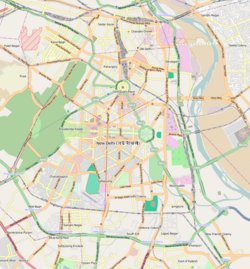| Kalan Mosque | |
|---|---|
 Kalan Masjid | |
| Religion | |
| Affiliation | Islam |
| Ecclesiastical or organizational status | Mosque |
| Status | Active |
| Location | |
| Location | Old Delhi, Central Delhi, Delhi NCT |
| Country | India |
Location of the mosque in Central Delhi | |
| Geographic coordinates | 28°38′42″N77°13′51″E / 28.64500°N 77.23083°E |
| Architecture | |
| Type | Mosque architecture |
| Completed | 1387 |
| Specifications | |
| Length | 43 m (140 ft) |
| Width | 37 m (120 ft) |
| Height (max) | 20 m (66 ft) |
| Dome(s) | Eight (maybe more) |
| Minaret(s) | Two (truncated) |
| Materials | Sandstone |
The Kalan Masjid, or Kalan Mosque, is a 14th-century mosque in Old Delhi, India. [1] [2] It is one of the seven mosques built by Khan-i-Jahan Tilangani. [3]


